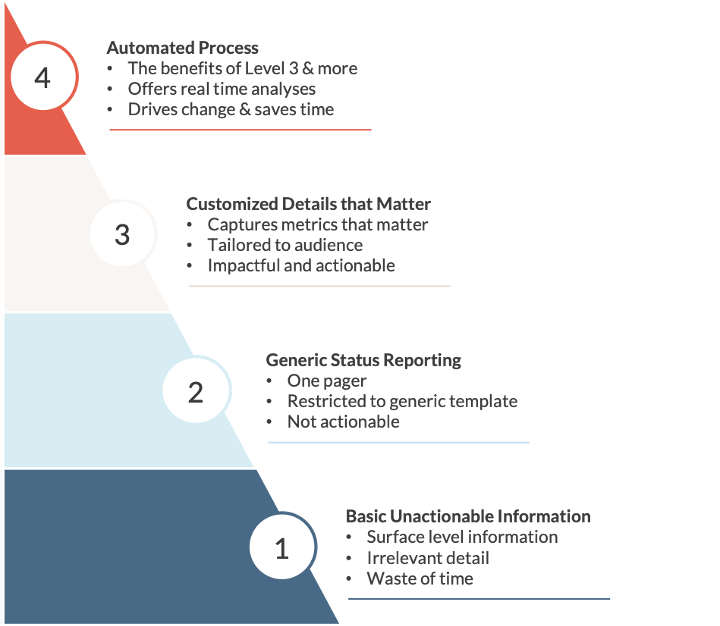Strategy
Apr 01, 2021
Ascending the Project Status Reporting Maturity Model: How to Provide Efficient Updates

Are your project status reports seen as a chore for your teams and a bore for your leaders? Many organizations and programs find themselves in this situation: the weekly status report takes an hour for the team to fill out, represents stale or outdated information, and doesn’t provide valuable insight to leadership. But we know keeping stakeholders informed is critical to program success, so how do we make the best use of our teams’ time and effectively track progress?
Project Status Reporting Maturity
The first step toward achieving an effective project status report is identifying what success looks like. At Credera, we track four levels of status reporting maturity: basic, standard, customized, and automated.
Credera’s Project Status Reporting Maturity Model:

Status reports can be basic, standard, customized, or automated.
Inefficiency at Lower Project Status Reporting Levels
Level one is a waste of time. It’s comprised of details that are either too in-the-weeds or not relevant for program level decisions. Teams typically spend over an hour on text-heavy input and iteration, and the information is stale by the time it’s reviewed. More often than not, reviews of these status reports are an exercise in futility where teams simply give their status with no subsequent follow up.
Level two provides some value by tracking progress, but the information isn’t actionable. Key accomplishments, milestone dates, and finances are made transparent, but important, project-specific details are left out and the call to action is missing. Programs can get stuck here with a standard template that’s not very relevant to their work and doesn’t drive movement, but it checks the boxes for most program management office (PMO) groups.
Impactful at Higher Project Status Reporting Levels
Customized and automated reports share a few key attributes that make for an effective status update:
Relevant: The information checks the boxes for the PMO (e.g., milestones, finances) but also includes project-specific information.
Visual: Key metrics and overall status are tracked with visual cues utilizing simple graphs, symbols, and colors.
Succinct: Status provides the appropriate level of detail for consumption by project leadership and executives—more often than not, less is more.
Actionable: Provides executives or project leadership with a clear request for decisions, risk mitigation, or additional support as required.
Timely: Details are reviewed on a regular cadence, but the status aggregation process doesn’t hold up the information flow.
Program size, duration, complexity, and strategic importance should all factor into the decision on whether to invest in automation to reach level four status reporting. However, elevating status reports to customization at level three is almost always worth the extra up-front effort to drive real change in programs. To ascend to level three status reporting, teams must:
Conduct quick discovery:
Determine the key stakeholders and workstreams.
Align on reporting expectations.
Define success factors and key metrics.
Develop and iterate:
Create visual components based on lessons from discovery.
Identify key status subjects and start with less.
Be willing to pivot and adapt to leadership’s needs.
How to Level Up Your Project Status Reporting
Discovery: Define Measurements That Matter
One of the most important initial investments to make is ensuring the status information provided by teams is relevant to the audience. Ask questions about who will be reading the status reports and for what purpose. Is it for the PMO to understand how many projects are “red,” “yellow,” or “green?” Is the audience technical? Does it go to a program lead or as high as executives? Are funding decisions being made with this report? Are technical investments prioritized based on this information? These types of questions will help you understand what tone and level of detail is most helpful for the program status.
Once you determine the who and the why, gather explicit expectations as well. Does the PMO have a defined framework for what it means to be on track versus at risk? If there are defined frameworks, stick to them when analyzing overall status. Is there an emphasis on reducing operating expenses currently? Show the capital expense and operating expense breakdown for each workstream. Take note of the required elements but force the conversation to layer in more meaningful information as well.
Discuss what it means for this program specifically to succeed. This should go beyond the scope, schedule, and budget factors. It could be the number of widgets expected per week, the acceptable threshold of bugs within an application, or the percent of users who have been trained on the new process. If there are items that contribute to the program’s success that are tracked week over week (or could be an early indicator of being off track), put them front and center.
Development: Consider Figures and Format
As you bring all of the above elements together, do your best to create visual status reports. A reader should be able to tell how the project is going with a quick glance. Utilize symbols and colors (in conjunction for accessibility) to denote scope schedule and budget trends, but don’t forget to call attention to your more customized metrics as well. If you’re tracking progress of users being trained, for example, consider using a pie chart overlayed with percentages to quickly show progress without forcing the audience to read a bullet point with the metrics.
When in doubt, leave it out. If there are several additional elements that might be helpful, but your one-pager is getting dense, keep them on the backburner. Too much information loses an audience. Instead, consider links or follow up slides with the details. This could take the form of a risks and issues tracker, a decision log, a detailed timeline, or a secondary dashboard report with the minor metrics.
Visual Measurements and Referenceable Details:

Provide key status metrics visually and leave the details in a separate log for reference.
Last but not least, prepare to pivot. If you find yourself continuing to dive into those extra slides or talking about a minor metric every time you meet, consider pulling it forward. Adjust the report to be most helpful for the moment or phase of the project. But don’t forget this goes the other way as well. If items are no longer relevant—clean house! Teams can become frustrated when they need to fill out information each week that doesn’t apply to them or no longer aligns with the goals of the initiative. A cleaner status summary makes for happier readers!
Continuous Project Status Reporting Improvement
Once implemented, keep an eye on the way the status report is utilized. Does it seem like it’s never read? Are there five meetings a week to discuss it? Is it the only way stakeholders are gaining insight to the project? Consider calibrating the implementation approach in addition to the content itself.
A few key tips:
1. Don’t use status as a crutch. Utilize daily scrums or real-time collaboration tools such as Microsoft Teams to stay in touch. Beware of waiting until the Friday status report to know what’s going on with your program. Ideally, a project manager or program lead would be informed enough to create a draft weekly status report and have each workstream lead conduct a quick review with light edits and input.
2. Ask for feedback! On both the content and the delivery. Weekly status meetings are often a habit. Sometimes this results in a weekly team status, a weekly program lead status, a weekly stakeholder status, etc., and core team members spend the whole week discussing what happened last week. Don’t be afraid to ask for the team’s thoughts: “Is this meeting helpful for you?” “Are you usually able to review the report beforehand?” “Should we adjust the cadence?”
3. Automate and scale as desired. Consider whether the program is conducive to a level-four type of investment in an online dashboard with real-time updates. Collaboration tools allow team members to provide streamlined inputs. They might mark an activity as complete at the end of the day and see the scope complete percentage increment automatically or put in a few key details and have the overall status color change based on business logic. This allows teams to focus more on moving the project forward and less on how they are classifying or presenting the work they’ve already done. Automation also provides greater transparency when a stakeholder can log in to see in-progress activities versus waiting for an end of week recap.
Invest in Your Project Status Reporting Efforts
Investment in status reporting processes and structure will yield more than just informed stakeholders. When subject matter experts can clearly communicate needs and executives have the right knowledge to make decisions, impactful updates lead to dramatic, program-wide results. If you or your team are interested in support for setting up PMO structure or providing executional excellence via project or program leadership, check out our services here or reach out to marketing@credera.com.
Contact Us
Let's talk!
We're ready to help turn your biggest challenges into your biggest advantages.
Searching for a new career?
View job openings




